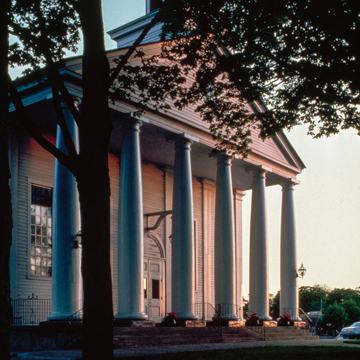You are here
Pillar Christian Reformed Church (Old First Reformed Church, Ninth Street Christian Reformed Church)
One of the few buildings to survive the fire of 1871 that destroyed most of Holland, this is Holland's oldest church building. The clapboard frame and six widely spaced columns of the temple-front church are constructed of hand-hewn oak. The Doric order, however, is Palladian, not Greek, and thus typical of many provincial temple-form buildings of the Greek Revival era in which a Palladian or Roman order was used. Also not Greek is the three-stage octagonal arched bell tower with a cupola, which tops the square tower. The church stands on land given to the congregation by the Reverend Albertus C. Van Raalte, founder and first pastor of the Holland colony. It was built to the designs of Schrader (1812–1899) of Holland by local builders Verbeek, Venema, Zalsman, and Slenk, with the assistance of volunteers from the congregation. The present church replaced a log church that was located on the site of Pilgrim Rest Cemetery. In 1884 the majority of the congregation seceded as part of a larger religious movement in the community to the Christian Reformed denomination.
Writing Credits
If SAH Archipedia has been useful to you, please consider supporting it.
SAH Archipedia tells the story of the United States through its buildings, landscapes, and cities. This freely available resource empowers the public with authoritative knowledge that deepens their understanding and appreciation of the built environment. But the Society of Architectural Historians, which created SAH Archipedia with University of Virginia Press, needs your support to maintain the high-caliber research, writing, photography, cartography, editing, design, and programming that make SAH Archipedia a trusted online resource available to all who value the history of place, heritage tourism, and learning.











